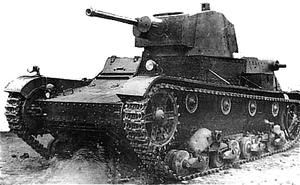7TP
| 7TP | |
|---|---|

Single-turret 7TP
|
|
| Type | Light tank |
| Place of origin | Poland |
| Service history | |
| Used by | Poland Nazi Germany (captured) |
| Wars | World War II |
| Production history | |
| Produced | 1935–1939 |
| No. built | 149 (+13 9TP prototypes) |
| Variants | twin-turret 7TP 9TP (prototypes only) |
| Specifications | |
| Weight | 9.9 tonnes |
| Length | 4.6 m |
| Width | 2.4 m |
| Height | 2.27 m |
| Crew | 3 (commander, gunner, driver) |
|
|
|
| Armor | 17 mm |
|
Main
armament |
1×37 mm Bofors wz. 37 |
|
Secondary
armament |
1×7.92 mm Ckm wz.30 |
| Engine | PZInż.235(Saurer VBLDd) Liquid-cooled inverted inline 6-cylinder 4-stroke direct injection diesel 110 hp (80 kW) |
| Power/weight | 11 hp/tonne |
| Suspension | leaf-spring bogie |
| Ground clearance | 381 mm |
|
Operational
range |
150 km |
| Speed | 37 km/h |
The 7TP (siedmiotonowy polski - 7-tonne Polish) was a Polish light tank of the Second World War. A development of the British Vickers 6-ton, it was significantly better armed than its most common opponents, the German Panzer I and Panzer II. A standard tank of the Polish Army during the 1939 Invasion of Poland, its production never exceeded 150 vehicles. Its chassis was used as the base for C7P artillery tractor.
The 7TP was the Polish development of the British Vickers 6-ton Mark E tank licence. Comparing to Vickers, the main new features of 7TP were: a better, more reliable and powerful diesel engine, a 37 mm anti-tank gun, thicker armour (17 mm instead of 13 mm on the front), modified ventilation, the Gundlach tank periscope, and a radio. About 132 tanks were produced between 1935 and the outbreak of the war, plus four iron prototypes. The designation 7TP meant "7 Tonne, Polish" (in fact its weight increased to 9 tonnes after the initial prototype).
Although 7TP is often claimed to be the world's first (production) diesel-powered tank, this distinction actually goes to Japanese Type 89B I-Go Otsu, produced with a diesel engine from 1934 onwards. Barring that, the claim of a first purpose-designed diesel-powered tank is tied with Type 95 Ha-Go, whose series production also commenced in 1935.
Like its British predecessor, the 7TP was initially produced in two variants: twin turret version armed with 2 Ckm wz.30 machine guns, and a single turret version, armed with 37 mm Bofors wz. 37 gun. After initial tests, it became clear that the twin-turret variant was obsolete and lacked firepower, so it was abandoned in favour of the more modern single turret design.
...
Wikipedia
